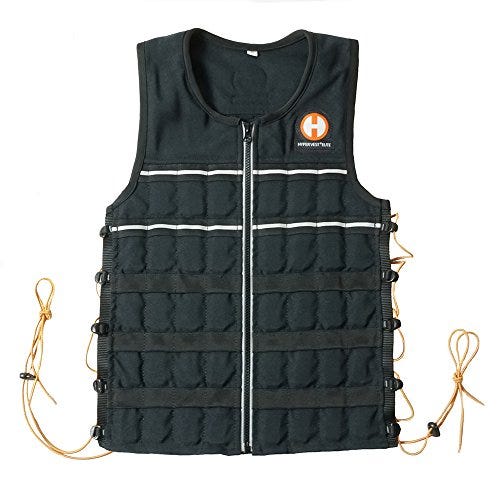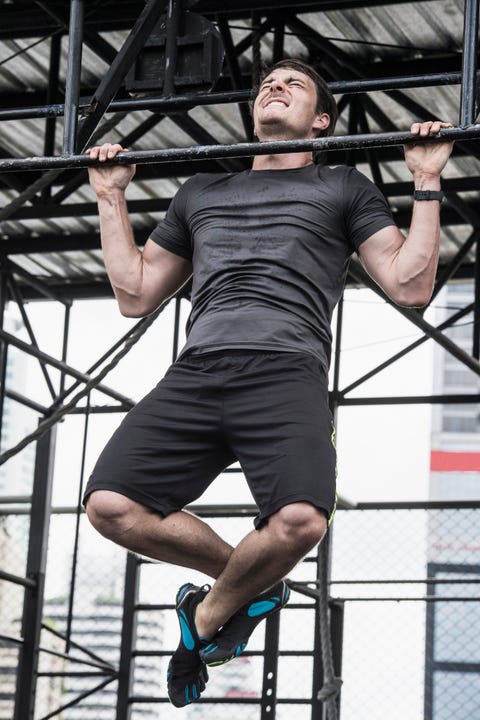Yes, You Can Handle CrossFit's Memorial Day Murph Challenge
There are a handful of CrossFit hero WODs out there, benchmark workouts that were named for fallen service members and meant to push you to your limits. But there may not be a hero WOD more revered (or challenging) than Murph.
You know all about Murph if you train at a CrossFit box around Memorial Day. Named after Navy SEAL Lieutenant Michael Patrick Murphy, Murph is the workout of choice at boxes on Memorial Day, CrossFit’s way of honoring the men and women of the armed forces who’ve lost their lives.
Murphy was a Navy Seal who was killed in action in Afghanistan. He was posthumously awarded the Medal of Honor, the U.S. military’s highest decoration, for his actions, becoming the first U.S. Navy member to receive the award since the days of the Vietnam War. He designed Murph while on deployment, and it became one of his go-to workouts. It’s become a favorite of Hollywood celebs as well, with the likes of Chris Pratt, Dwayne Johnson, and John Krasinski all gutting it out to raise awareness for veterans’ issues.
It’s also one of CrossFit’s most intimidating hero WODs, thanks to a pair of one-mile runs (yes, two of them), and some big numbers for the calisthenic movements. Fighting through Murph demands both physical and mental fortitude, especially if you do it the way it’s meant to be done, wearing a 20-pound weight vest for the entire endeavor.
But you can take down Murph. You just need a smart plan. That’s what I’m going to give you right now.
The Workout
There are two ways to get through Murph, neither of which is easy. Either way, you work through the following pieces.
When the event showed up in the 2016 CrossFit Games, it was contested “unpartitioned,” meaning you had to complete all the moves in order, finishing all 100 pullups before moving onto the pushups, then finishing all your pushups before moving to the squats.

At most boxes, though, you’ll see people doing it “partitioned.” That means you’re permitted to complete the pullups, pushups, and squats in any order and way you see fit. You may do, say, 10 pullups, 20 pushups, and 30 air squats for 10 sets. Doing it this way helps you move faster, since one muscle group can recover (at least a little bit) while another one is being worked.
Either way, it’s all about pacing. And either way, if you really want the true Murph experience, you’ll do the entire gauntlet while wearing a 20-pound weight vest.
Need a weight vest for your Murph? Check out this option from Hyper Wear, or any of these great choices.
Setting Your Murph Goal
Some CrossFit workouts are sprints. This isn’t one of them. You’ll want to pace yourself, and should expect a 30- to 40-minute grind — if not more. A beginner should expect to finish Murph in 50 minutes. More experienced CrossFitters can shoot to finish in 35 minutes. I’m shooting to finish in less than 32 minutes.
Those times, by the way, are for the partitioned version of Murph; the unpartitioned version is even more vicious. For proof, check out the 2016 CrossFit Games, when the unpartitioned version of Murph was an event. Josh Bridges finished first in 34:38. Mat Fraser, a three-time champ, was second in 35:48. Take on the unpartitioned Murph at your own risk.
All that said, this workout is relative to you! Once you figure out a strategy, step back and estimate a goal for completing it based on how proficient you are in pullups, pushups, and air squats. And remember: That weight vest will catch up with you after awhile, no matter how strong you are in those calisthenics movements.
Your Murph Game Plan
We’re going to focus on the partitioned version of Murph in this breakdown, because that’s the more common challenge. There’s also loads of strategy within Murph, too. We can mentally break the challenge into three parts: The opening mile, the movements, and the final mile.
Your First Mile
Like many longer-duration CrossFit workouts that open with a cardio-based buy-in, the opening mile run won’t win you this workout, but it could ruin things for you. It’s common for people to want to fly out of the gate, but unless you’re a very experienced runner, you shouldn’t do this. Instead, start out at a moderate, comfortable pace, get the nerves out, then gradually pick up the pace as the run wears on. You don’t want to burn out on this mile, because the “meat” of the workout is still ahead.

Cavan ImagesGetty Images
Think about breaking your mile into quarters or thirds, and pick up the pace with each interval. Comfortable running an 8-minute mile? Then start with an 8:30 pace and try to finish at a 7:30 pace. You should only be operating at 70 to 75 percent of your best mile capacity on this run.
The Movements
Once you’re through the run, it’s onto those exercises. And while the moves may seem simple (pushups and squats are pretty basic), you still need a plan here. To achieve your best time, you need to partition reps so you can keep moving the entire time without hitting failure and missing a rep. Your goal is to do a set amount of reps of the pullup, then come down and do a set amount of reps of the pushup, then do a set amount of reps of the squat; you’ll repeat your rep scheme until you’ve finished off all the required reps of all three moves. Your goal is to minimize rest; it’s OK to break the reps up into many sets, but keep moving!
Like most long CrossFit workouts, little details can go a long way in this workout, too. So optimize your setup before diving into the exercises. You want to find a pullup bar that you don’t have to jump too high to reach. Also, find your best pushup position before fatigue sets in. Chalk your hands heavily and put handprints on the floor to mark your ideal hand position. Plan for your hands to be in position directly underneath the pullup bar; that’ll allow you to drop to the floor seamlessly and go straight into each set of pushups. Aim to squat directly under the bar as well; that’ll position you ideally to jump back onto the bar and do pullups after your last set of squats.
Most people will eventually run into problems on either the pullups or the pushups (or both). Your shoulders and chest are smaller muscle groups, so they’ll fatigue quickly and need to recover. Again, that’s why you should play to your strengths and be creative in how you break up the reps. Let’s run through the movements, then dissect a few common rep schemes.
Pullup

Henn PhotographyGetty Images
You want to be very familiar with your pullup capacity. You’re coming off the run and your upper body may seem fresh and ready to go, so it’s tempting to bang out a big set of pullups. Don’t do it, though, because it’ll wear you down by the time you’re onto the final 50 pullups. Instead, find a number of reps you can do consistently under fatigue. For most, that may be 5 reps or less — and that’s OK.
Whatever rep scheme you choose, if you’re resting too much, cut it back. Don’t even be afraid to do quick singles. The goal is to be consistent and minimize rest. Aim to come off the pullup bar and rest no more than 1 to 3 seconds before jumping back on for more reps.
Note too: This is also the workout where you’ll want to bust out kipping pullups if you’re comfortable and proficient at kipping mechanics. Strict pullups will take you even longer to battle through.
Pushup
For most people, Murph becomes a pushup workout, because they aren’t ready for how quickly their chest will wear down. Much like the pullups, don’t attempt big sets early. Whatever rep scheme you choose, aim to stick with 10 reps or less at a time, and when your chest begins to fatigue, break things up just a little more. For example, if you’re doing sets of 10 and starting to struggle, do a set of 5, followed by a 2 or 3-second rest, and then another set of 5. If you start to really struggle, do single pushups, resting 1 to 2 seconds between each rep. Two hundred pushups is a lot. Don’t underestimate them—and don’t lose your form either. For a quick primer on pushup form, check out the video here.
Air Squat
The goal on the squats: Keep moving! Your legs are going to feel tired from the run, but they’re your biggest muscle group and they have the capacity to do big sets here. Pick a number you know you can achieve unbroken each time (for most of us, that’s around 20 reps). It’ll hurt, but that’s OK. Grind through these squats so you can rest a little more when you get to your pullups and pushups.
The Rep Schemes
10 rounds of: 10 pullups, 20 pushups, 30 air squats
While this rep scheme may look straightforward, if this is your first time attempting “Murph”, think twice. It’ll drive you to the wall early, because remember, you’re already fatigued from the run. This is for elite athletes only, those who can do unbroken sets of 50 butterfly pullups and 75 pushups when fresh, because it gives them a chance to move quickly.
20 rounds of: 5 pullups, 10 pushups, 15 air squats
This rep scheme mirrors Cindy, another CrossFit workout, and it’s one of the most popular strategies. If you’re above-average at pullups and pushups and can comfortably do 40-plus straight pushups when fresh, this one’s for you.
20 rounds of: 5 pullups, 5 pushups, 15 air squats, 5 pushups
Again, pushups are the Achilles’ heel for most in this workout. Here, we’re breaking them into two sets of 5 reps, separated by those 15 air squats. That little breather between pushups gives your chest a little more recovery, and it should keep you from hitting failure early on in this. If you’re skipping the kipping pullups and attacking Murph with strict pullups, consider this your option; you get plenty of time to recover between sets of strict pullups. It’s not, however, your best strict-pullups option.
50 rounds of: 2 pullups, 4 pushups, 6 air squats
Yes, 50 rounds sounds intimidating, but each round is quick and super-achievable. If you work through this rep scheme and don’t need to rest between anything, your only rest will come during movement-to-movement transitions. If you’re aiming to do strict pullups, make this your go-to format your first time around.
The Second Mile

Corey JenkinsGetty Images
Now, you’re tired, but you’re almost done. The goal of the second mile-run is similar to the first: Break it up into thirds and aim to get faster during each third. You’re exhausted now, but that’s OK.
Don’t let yourself take a break to start the run, though. It’s crucial that as soon as you finish your last bodyweight rep, you start running. Don’t walk. Even if it’s a slow jog, get your legs moving and use that first third of a mile to catch your breath while still moving. Once you settle in, pick up the pace. Then empty the tank on the final third. Dig deep! You’ll be proud of yourself when it’s all over.
Source: Read Full Article
